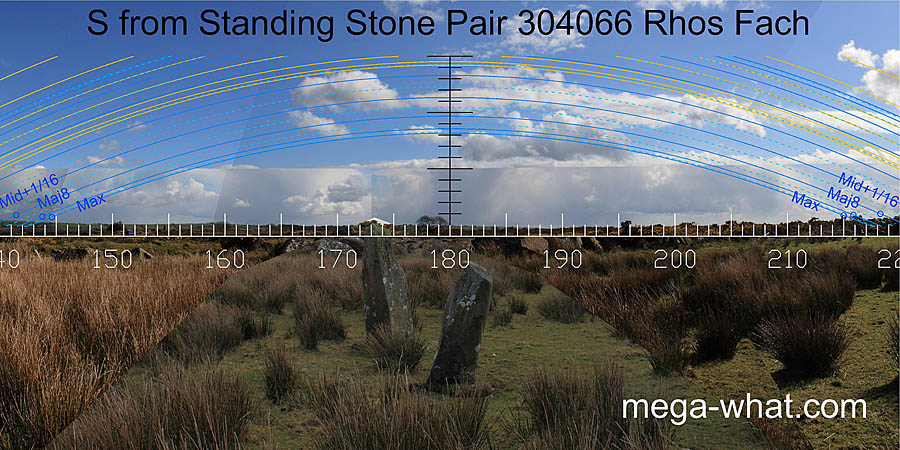 Rhos Fach Standing Stone Pair was perhaps a Stone Row.
Rhos Fach Standing Stone Pair was perhaps a Stone Row.Records indicate that there may have been a third smaller stone at this site but there is no sign of it now. Overall axis is NNW/SSE, between the major standstillsLunistice positions vary cyclically over an 18.6 year period but are fairly static for more than a year at either end of the range and north/south. The stone axes are markedly different.
South is at the left side of a dip, on the last hill of the south-eastern ridge before its intersect with the western slope and is indicated by the axis of the smaller stone.
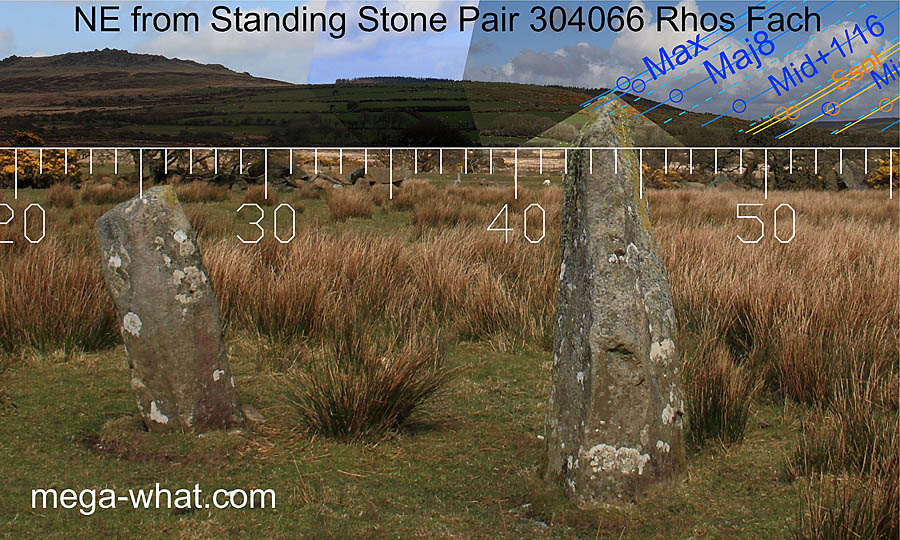 The axis of the larger stone indicates lunar major standstillLunistice positions vary cyclically over an 18.6 year period but are fairly static for more than a year at either end of the range
to the north-east.
The axis of the larger stone indicates lunar major standstillLunistice positions vary cyclically over an 18.6 year period but are fairly static for more than a year at either end of the range
to the north-east.
LunisticeLunistices are the most northerly and southerly moons of the month. The lunar equivalent of solstices - more. moon rises may be observed in this direction during the second half of the year, culminating with winter solstice full moon.
 Overall form is approximate symmetry around south which is in a wide dip. To both sides: The south lunisticeLunistices are the most northerly and southerly moons of the month. The lunar equivalent of solstices - more.
zone runs up a slope.
The central solar sequence spans a block of high ground and then the northern lunisticeLunistices are the most northerly and southerly moons of the month. The lunar equivalent of solstices - more.
zone runs up a slope to terminate at the top of a slope at the edge of a hill.
North is on the left side of a dip, at the foot of a hill [Pic].
Overall form is approximate symmetry around south which is in a wide dip. To both sides: The south lunisticeLunistices are the most northerly and southerly moons of the month. The lunar equivalent of solstices - more.
zone runs up a slope.
The central solar sequence spans a block of high ground and then the northern lunisticeLunistices are the most northerly and southerly moons of the month. The lunar equivalent of solstices - more.
zone runs up a slope to terminate at the top of a slope at the edge of a hill.
North is on the left side of a dip, at the foot of a hill [Pic].
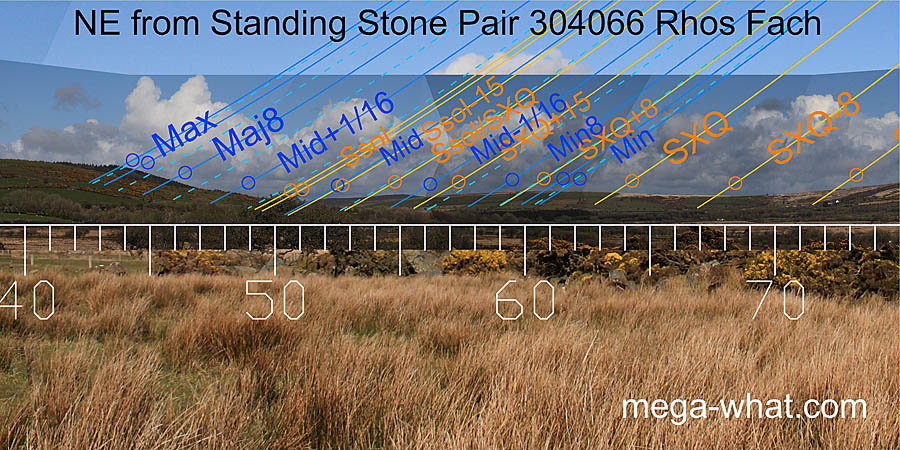 North-eastwards, lunar minor standstillLunistice positions vary cyclically over an 18.6 year period but are fairly static for more than a year at either end of the range
is on the top of Maes-y-Garn though the cairn is now gone.
Major standstillLunistice positions vary cyclically over an 18.6 year period but are fairly static for more than a year at either end of the range
is at the top of a slope and the midpoint is marked by the northern slope of Freni Fawr and the intersect notch which is also a solstice indicator.
North-eastwards, lunar minor standstillLunistice positions vary cyclically over an 18.6 year period but are fairly static for more than a year at either end of the range
is on the top of Maes-y-Garn though the cairn is now gone.
Major standstillLunistice positions vary cyclically over an 18.6 year period but are fairly static for more than a year at either end of the range
is at the top of a slope and the midpoint is marked by the northern slope of Freni Fawr and the intersect notch which is also a solstice indicator.
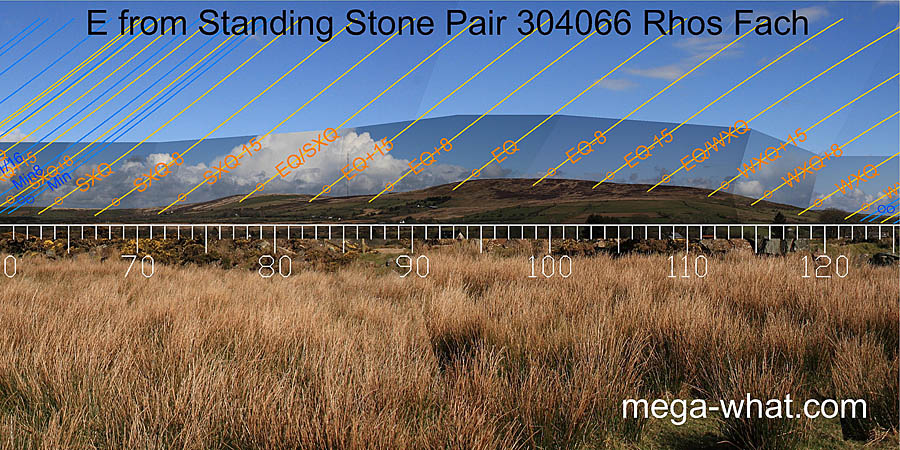 To the east, a subtle fit is more useful than it may first appear to be. Most obviously, winter cross-quarters are Foel Drych's southern foot while its top is a week before spring equinox.
To the east, a subtle fit is more useful than it may first appear to be. Most obviously, winter cross-quarters are Foel Drych's southern foot while its top is a week before spring equinox.
 winter cross-quarters are at the intersect of Garn Wen with nearer ground.
Concealed by a tree, Garn Wen's other intersect is a quarter-month further south and marks the beginning of the lunisticeLunistices are the most northerly and southerly moons of the month. The lunar equivalent of solstices - more.
zone.
The lunisticesLunistices are the most northerly and southerly moons of the month. The lunar equivalent of solstices - more.
run down through a dip which marks the midpoint, up to a top which is a sixteenth and on down slope to the
major standstillLunistice positions vary cyclically over an 18.6 year period but are fairly static for more than a year at either end of the range.
The major eighth would have risen from Carn Besi chambered tomb.
winter cross-quarters are at the intersect of Garn Wen with nearer ground.
Concealed by a tree, Garn Wen's other intersect is a quarter-month further south and marks the beginning of the lunisticeLunistices are the most northerly and southerly moons of the month. The lunar equivalent of solstices - more.
zone.
The lunisticesLunistices are the most northerly and southerly moons of the month. The lunar equivalent of solstices - more.
run down through a dip which marks the midpoint, up to a top which is a sixteenth and on down slope to the
major standstillLunistice positions vary cyclically over an 18.6 year period but are fairly static for more than a year at either end of the range.
The major eighth would have risen from Carn Besi chambered tomb.
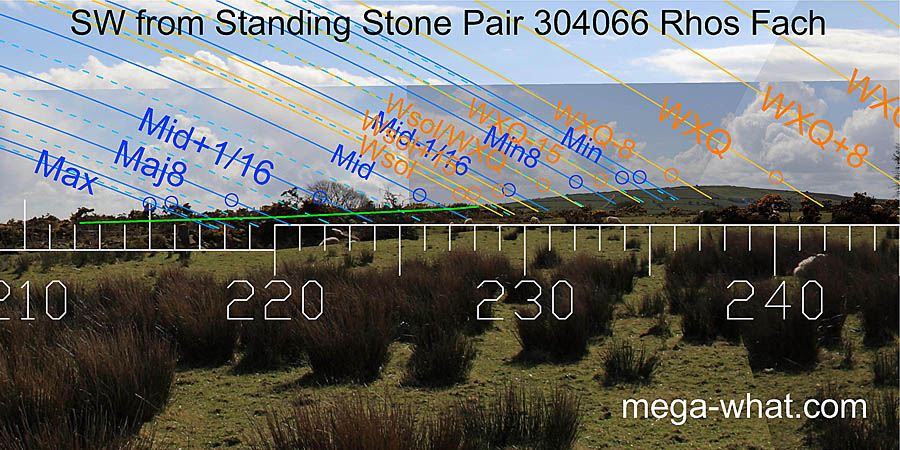 The south-west is partially obscured by gorse and a field boundary wall but the hidden horizon is a fairly bland slope.
It looks like the lunar midpoint or perhaps the solstice are at the hill's basal step.
The south-west is partially obscured by gorse and a field boundary wall but the hidden horizon is a fairly bland slope.
It looks like the lunar midpoint or perhaps the solstice are at the hill's basal step.
 The most obviously useful fit in the west is the equinox on a hilltop.
The equinox / summer cross-quarter midpoint is at the basal step of Foelcwmcerwyn's summit and more may be found by those with a keen eye.
The most obviously useful fit in the west is the equinox on a hilltop.
The equinox / summer cross-quarter midpoint is at the basal step of Foelcwmcerwyn's summit and more may be found by those with a keen eye.
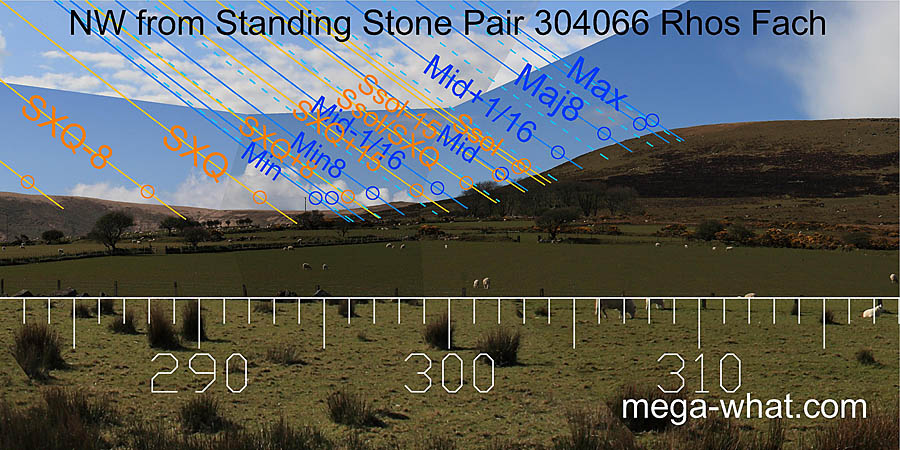 Summer cross-quarter and lunar minor standstillLunistice positions vary cyclically over an 18.6 year period but are fairly static for more than a year at either end of the range
are either side of the north-western dip. The following top also splits lunar and solar marks.
Major standstillLunistice positions vary cyclically over an 18.6 year period but are fairly static for more than a year at either end of the range
is at a break between steep and less steep ground at the top of the slope.
Summer cross-quarter and lunar minor standstillLunistice positions vary cyclically over an 18.6 year period but are fairly static for more than a year at either end of the range
are either side of the north-western dip. The following top also splits lunar and solar marks.
Major standstillLunistice positions vary cyclically over an 18.6 year period but are fairly static for more than a year at either end of the range
is at a break between steep and less steep ground at the top of the slope.
The pair axis bisects the space between major standstillLunistice positions vary cyclically over an 18.6 year period but are fairly static for more than a year at either end of the range and north [Pic].
See other views of these stones here.
- Gors Fawr Standing Stone Pair is 1km south.
- Cwm Garw Standing Stone Pair is 1.6km to the west-north-west.
References
- National Monuments Record of Wales: Coflein database - site details.
- FIGGIS, N.P. 2001 Prehistoric Preseli a field guide. Machynlleth: Atelier Productions. p97, no.95.
